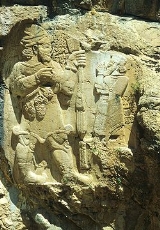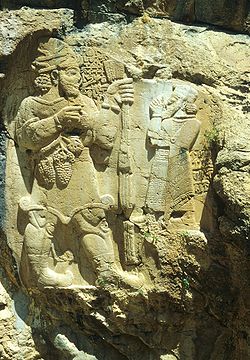
Ivriz
Encyclopedia
Ivriz is an Iron Age
archaeological site of a Neo-Hittite
rock-relief monument and cult place in south-central Anatolia
(modern Turkey
, province of Konya
, immediately south-east of the modern town of Ereğli). The rock relief depicts the late 8th c. BC Tabalian king Warpalawas
and the Storm-God Tarhunzas and is accompanied with a hieroglyphic Luwian inscription.

Iron Age
The Iron Age is the archaeological period generally occurring after the Bronze Age, marked by the prevalent use of iron. The early period of the age is characterized by the widespread use of iron or steel. The adoption of such material coincided with other changes in society, including differing...
archaeological site of a Neo-Hittite
Neo-Hittite
The states that are called Neo-Hittite, or more recently Syro-Hittite, were Luwian, Aramaic and Phoenician-speaking political entities of the Iron Age northern Syria and southern Anatolia that arose following the collapse of the Hittite Empire around 1180 BC and lasted until roughly 700 BC...
rock-relief monument and cult place in south-central Anatolia
Anatolia
Anatolia is a geographic and historical term denoting the westernmost protrusion of Asia, comprising the majority of the Republic of Turkey...
(modern Turkey
Turkey
Turkey , known officially as the Republic of Turkey , is a Eurasian country located in Western Asia and in East Thrace in Southeastern Europe...
, province of Konya
Konya
Konya is a city in the Central Anatolia Region of Turkey. The metropolitan area in the entire Konya Province had a population of 1,036,027 as of 2010, making the city seventh most populous in Turkey.-Etymology:...
, immediately south-east of the modern town of Ereğli). The rock relief depicts the late 8th c. BC Tabalian king Warpalawas
Warpalawas
Warpalawa was a late 8th century BC Late Hittite king of Tabal in south-central Anatolia . The political center of this Early Iron Age regional state was probably Tuwanuwa .Among other commemorative monuments, Warpalawas most notably commissioned the carving of a rock-relief at the site of Ivriz...
and the Storm-God Tarhunzas and is accompanied with a hieroglyphic Luwian inscription.


